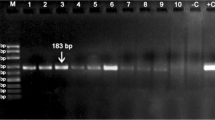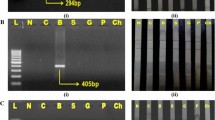Abstract
Species determination of tissue specimens, including blood, is an important component of forensic analysis to distinguish human from animal remains. DNA markers based on a method of species-specific PCR and amplifying the 359-base pair (bp) fragment of the mitochondrially encoded cytochrome-b gene and then digestion with the TaqI restriction enzyme were developed for detection and discrimination of human, cattle, buffalo, horse, sheep, pig, dog, cat and chicken blood samples. The results reveal that PCR-amplification of the gene encoding the species-specific repeat (SSR) region generated 603 bp in cattle and buffalo, 221 bp in horse, 374 bp in sheep, ≤100 bp in pig, 808 bp in dog, 672 bp in cat and 50 bp in chicken. Restriction analysis of the amplified 359-bp portion of the cytochrome-b gene using the TaqI restriction enzyme results in species-specific restriction fragment length polymorphism (RFLP) between buffalo, cattle and human. Two different bands were generated in buffalo (191 and 168 bp) and human (209 and 150 bp), with no digestion in cattle (359 bp). Cytochrome-b is a highly conserved region and consequently a good molecular marker for diagnostic studies. Therefore, the two complementary techniques, SSR-PCR and PCR–RFLP, could be used successfully as routine methods in forensics for sensitive, rapid, simple and inexpensive identification of the species in bloodstains.




Similar content being viewed by others
Abbreviations
- bp:
-
Base pairs
- cyt-b :
-
Cytochrome-b
- D-loop:
-
Displacement loop
- mtDNA:
-
Mitochondrial DNA
- PCR:
-
Polymerase chain reaction
- RAPD:
-
Random amplified polymorphic DNAs
- RE:
-
Restriction enzyme
- RFLP:
-
Restriction fragment length polymorphism
- SSR:
-
Species-specific repeat
- STR:
-
Short tandem repeat
References
DeForest PR, Gaensslen RE, Lee HC. Forensic science: an introduction to criminalistics. New York: McGraw-Hill; 1983.
Miller-Coyle H. International forensic science and investigation series, nonhuman DNA typing: theory and casework application. Boca Raton: CRC Press; 2008.
Bartlett SE, Davidson WS. FINS (Forensically Informative Nucleotide Sequencing): a procedure for identifying the animal origin of biological specimens. BioTechniques. 1992;12:82–92.
Wetton JH, Higgs JE, Spriggs AC, Roney CA, Tsang CSF, Foster AP. Mitochondrial profiling of dog hairs. Forensic Sci Int. 2003;133:235–41.
Andrasko J, Rosen B. Sensitive identification of hemoglobin in bloodstains from different species by high performance liquid chromatography with combined UV and fluorescence detection. J Forensic Sci. 1994;39:1018–25.
Hsieh YH, Sheu SC, Bridgman RC. Development of a monoclonal antibody specific to cooked mammalian meats. J Food Prot. 1998;61:476–81.
Skarpeid HJ, Kvaal K, Hildrum KI. Identification of animal species in ground meat mixtures by multivariate analysis of isoelectric-focusing protein profiles. Electrophoresis. 1998;19:3103–9.
Espinoza EO, Lindley NC, Gordon KM, Ekhoff JA, Kirms MA. Electrospray ionization mass spectrometric analysis of blood for differentiation of species. Anal Biochem. 1999;268:252–61.
Czesny S, Dabrowski K, Christensen JE, Eenennaam JV, Doroshov S. Discrimination of wild and domestic origin of sturgeon ova based on lipids and fatty acid analysis. Aquaculture. 2000;189:145–53.
Lowenstein JM, Reuther JD, Hood DG, Scheuenstuhl G, Gerlach SC, Ubelaker DH. Identification of animal species by protein radioimmunoassay of bone fragments and bloodstained stone tools. Forensic Sci Int. 2006;159:182–8.
Chou CC, Lin SP, Lee KM, Hsu CT, Vickroy TW, Zen JM. Fast differentiation of meats from fifteen animal species by liquid chromatography with electrochemical detection using copper nanoparticle plated electrodes. J Chromatogr B Analyt Technol Biomed Life Sci. 2007;846:230–9.
Jobin R, Patterson DK, Stang C. Forensic DNA typing in several big game animals in the province of Alberta. Can Soc Forens Sci J. 2003;36:56.
Guglich EA, Wilson PJ, White BN. Forensic application of repetitive DNA markers to the species identification of animal tissues. J Forensic Sci. 1994;39:353–61.
Murray BW, McClymont RA, Strobeck C. Forensic identification of ungulate species using restriction digests of PCR-amplified mitochondrial DNA. J Forensic Sci. 1995;40:943–51.
Lee JC, Chang JG. Random amplified polymorphic DNA polymerase chain reaction (RAPD PCR) fingerprints in forensic species identification. Forensic Sci Int. 1994;67:103–7.
Coomber N, David VA, O’Brien SJ, Menotti-Raymond M. Validation of a short tandem repeat multiplex typing system for genetic individualization of domestic cat samples. Croat Med J. 2007;48:547–55.
Jain S, Brahmbhait MN, Rank DN, Joshi CG, Solank JV. Use of cytochrome b gene variability in detecting meat species by multiplex PCR assay. Indian J Anim Sci. 2007;77:880–1.
Walker JA, Hughes DA, Anders BA, Shewale J, Sinha SK, Batzer MA. Quantitative intra-short interspersed element PCR for species-specific DNA identification. Anal Biochem. 2003;316:259–69.
Lorenzini R. DNA forensics and the poaching of wildlife in Italy: a case study. Forensic Sci Int. 2005;153:218–21.
Jonker KM, Tilburg JJ, Hagele GH, de Boer E. Species identification in meat products using real-time PCR. Food Addit Contam Part A Chem Anal Control Expo Risk Assess. 2008;25:527–33.
Bellis C, Ashton KJ, Freney L, Blair B, Griffiths LR. A molecular genetic approach for forensic animal species identification. Forensic Sci Int. 2003;134:99–108.
Rastogi G, Dharne M, Bharde A, Pandav VS, Ghumatkar SV, Krishnamurthy R, et al. Species determination and authentication of meat samples by mitochondrial 12S rRNA sequence analysis and conformation-sensitive gel electrophoresis. Curr Sci. 2004;87:1278–81.
Martín I, García T, Fajardo V, Rojas M, Hernández PE, González I, et al. Technical note: Detection of cat, dog, and rat or mouse tissues in food and animal feed using species-specific polymerase chain reaction. J Anim Sci. 2007;85:2734–9.
Melton T, Holland C. Routine forensic use of the mitochondrial 12S ribosomal RNA gene for species identification. J Forensic Sci. 2007;52:1305–7.
Pereira F, Carneiro J, Amorim A. Identification of species with DNA-based technology: current progress and challenges. Recent Pat DNA Gene Seq. 2008;2:187–99.
Bellagamba F, Moretti VM, Comincini S, Valfrè F. Identification of species in animal feedstuffs by polymerase chain reaction-restriction fragment length polymorphism analysis of mitochondrial DNA. J Agric Food Chem. 2001;49:3775–81.
Pesole G, Gissi C, De Chirico A, Saccone C. Nucleotide substitution rate of mammalian mitochondrial genomes. J Mol Evol. 1999;48:427–34.
Rastogi G, Dharne M, Walujkar S, Kumar A, Patole MS, Shouche YS. Species identification and authentication of tissues of animal origin using mitochondrial and nuclear markers. Meat Sci. 2007;76:666–74.
Pfeiffer I, Burger J, Brenig B. Diagnostic polymorphisms in the mitochondrial cytochrome-b gene allow discrimination between cattle, sheep, goat, roe buck and deer by PCR-RFLP. BMC Genet. 2004;5:30.
Parson W, Pegoraro K, Niederstätter H, Föger M, Steinlechner M. Species identification by means of the cytochrome-b gene. Int J Legal Med. 2000;114:23–8.
Partis L, Croan D, Guo Z, Clark R, Coldham T, Murby J. Evaluation of a DNA fingerprinting method for determining the species origin of meats. Meat Sci. 2000;54:369–76.
Hsieh HM, Chiang HL, Tsai LC, Lai SY, Huang NE, Linacre A, et al. Cytochrome-b gene for species identification of the conservation animals. Forensic Sci Int. 2001;122:7–18.
Wolf C, Rentsch J, Hübner P. PCR-RFLP analysis of mitochondrial DNA: a reliable method for species identification. J Agric Food Chem. 1999;47:1350–5.
Bravi CM, Liron JP, Mirol PM, Ripoli MV, Peral-Garcia P, Giovambattista G. A simple method for domestic animal identification in Argentina using PCR-RFLP analysis of cytochrome-b gene. Leg Med. 2004;6:246–51.
Sharma D, Appa Rao KB, Totey SM. Measurement of within and between population genetic variability in quails. Br Poult Sci. 2000;41:29–32.
Jobse C, Buntjer JB, Haagsma N, Breukelman HJ, Beintema JJ, Lenstra JA. Evolution and recombination of bovine DNA repeats. J Mol Evol. 1995;41:277–83.
Abdulmawjood A, Schönenbrücher H, Bülte M. Development of a polymerase chain reaction system for the detection of dog and cat meat in meat mixtures and animal feed. J Food Sci. 2003;68:1757–61.
Wijers ER, Zijlstra C, Lenstra JA. Rapid evolution of horse satellite DNA. Genomics. 1993;18:113–7.
Jantsch M, Hamilton B, Mayr B, Schweizer D. Meiotic chromosome behaviour reflects levels of sequence divergence in Sus scrofa domestica satellite DNA. Chromosoma. 1990;99:330–5.
Chikuni K, Tabata T, Kosugiyama M, Monma M, Saito M. Polymerase chain reaction assay for detection of sheep and goat meats. Meat Sci. 1994;37:337–45.
Matzke MA, Varga F, Berger H, Schernthaner J, Schweizer D, Mayr B, et al. A 41–42 bp tandemly repeated sequence isolated from nuclear envelopes of chicken erythrocytes is located predominantly on microchromosomes. Chromosoma. 1990;99:131–7.
Kocher TD, Thomas WK, Meyer A, Edwards SV, Päabo S, Villablanca FX, et al. Dynamics of mitochondrial DNA evolution in mammals: amplification and sequencing with conserved primers. Proc Natl Acad Sci USA. 1989;86:6196–200.
Abdel-Rahman SM, Ahmed MM. Rapid and sensitive identification of buffalo’s, cattle’s and sheep’s milk using species-specific PCR and PCR–RFLP techniques. Food Control. 2007;18:1246–9.
Ahmed MM, Abd El-Rahman MS, El-Hanafy AA. Application of species-specific polymerase chain reaction and cytochrome-b gene for different meat species authentication. Biotechnology. 2007;6:426–30.
İlhak Oİ, Arslan A. Identification of meat species by polymerase chain reaction (PCR) technique. Turk J Vet Anim Sci. 2007;31:159–63.
Al-Sanjary RA. Identification of beef using restriction fragment length polymorphism-polymerase chain reaction. Iraqi J Vet Sci. 2009;23:43–6.
Author information
Authors and Affiliations
Corresponding author
Rights and permissions
About this article
Cite this article
El-Sayed, Y.S., Mohamed, O.I., Ashry, K.M. et al. Using species-specific repeat and PCR–RFLP in typing of DNA derived from blood of human and animal species. Forensic Sci Med Pathol 6, 158–164 (2010). https://doi.org/10.1007/s12024-009-9117-5
Accepted:
Published:
Issue Date:
DOI: https://doi.org/10.1007/s12024-009-9117-5




